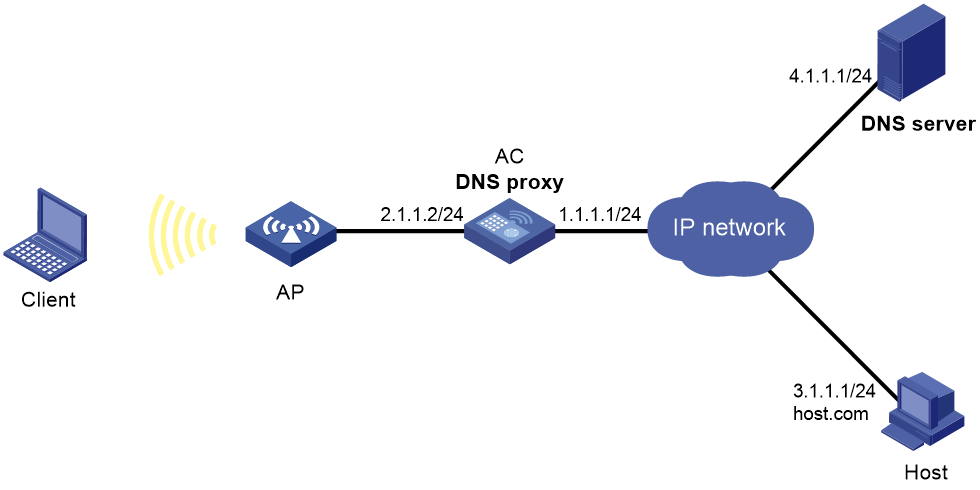- Table of Contents
-
- 03-Basic Network Configuration
- 01-Layer 2 Static Link Aggregation Configuration Example
- 02-Layer 2 Dynamic Link Aggregation Configuration Example
- 03-PPPoE Client Configuration Example
- 04-Static IPv6 Address Configuration Example
- 05-IPv6 Static Routing Configuration Example
- 06-Static IPv4 DNS Configuration Example
- 07-Static IPv6 DNS Configuration Example
- 08-Dynamic IPv4 DNS Configuration Example
- 09-Dynamic IPv6 DNS Configuration Example
- 10-IPv4 DNS Proxy Configuration Example
- 11-IPv6 DNS Proxy Configuration Example
- 12-Static NAT Configuration Example
- 13-Dynamic NAT Configuration Example
- 14-IPv4 ACL-Based Packet Filter Configuration Example
- 15-IPv6 ACL-Based Packet Filter Configuration Example
- 16-ARP Attack Protection Configuration Example
- 17-ARP Proxy Configuration Example
- 18-IGMP Snooping Configuration Example
- 19-MLD Snooping Configuration Example
- Related Documents
-
| Title | Size | Download |
|---|---|---|
| 10-IPv4 DNS Proxy Configuration Example | 92.28 KB |
|
|
|
H3C Access Controllers |
|
Comware 7 IPv4 DNS Proxy |
|
Configuration Example |
Copyright © 2024 New H3C Technologies Co., Ltd. All rights reserved.
No part of this manual may be reproduced or transmitted in any form or by any means without prior written consent of New H3C Technologies Co., Ltd.
Except for the trademarks of New H3C Technologies Co., Ltd., any trademarks that may be mentioned in this document are the property of their respective owners.
The information in this document is subject to change without notice.
Overview
The following information provides an example for configuring IPv4 DNS proxy to allow users to access a host through the DNS proxy. When the DNS server address is changed, you can change the configuration only on the DNS proxy instead of on each DNS client.
Prerequisites
The following information applies to Comware 7-based access controllers. Procedures and information in the examples might be slightly different depending on the software or hardware version of the H3C access controllers.
The configuration examples were created and verified in a lab environment, and all the devices were started with the factory default configuration. When you are working on a live network, make sure you understand the potential impact of every command on your network.
The following information is provided based on the assumption that you have basic knowledge of DNS proxy.
Example: Configuring IPv4 DNS proxy
Network configuration
As shown in Figure 1, the AC acts as the DNS proxy to relay DNS packets between wireless client and the DNS server. The wireless client accesses the host with domain name host.com through the DNS proxy.
Prerequisites
Configure static routes or a dynamic routing protocol on all devices to make sure the network connections are available.
Procedures
Configuring the DNS server
On the DNS server, configure the mapping between the host's domain name host.com and IPv4 address 3.1.1.1/24. (Details not shown.)
Configuring the AC
1. Configure basic wireless features on the AC. (Details not shown.)
2. Specify the DNS server IP address on the AC:
a. Click the System View tab at the bottom of the page.
b. From the navigation pane, select Network Configuration > Network Services > DHCP/DNS.
c. Click the IPv4 DNS tab.
d. Specify 4.1.1.1 as the DNS server IP address.
Table 1 Specifying the DNS server address
e. Click the Add icon ![]() .
.
3. Configure the AC as the DNS proxy:
a. On the IPv4 DNS tab, click the Advanced settings button ![]() .
.
b. Enable DNS proxy.
Figure 2 Enabling DNS proxy
Configuring the DNS client
On the DNS client, specify the DNS server 2.1.1.2. (Details not shown.)
Verifying the configuration
# Execute the ping host.com command on the client and verify that the client can resolve domain name host.com into IP address 3.1.1.1.
C:\Users\aa>ping host.com
Ping host.com (3.1.1.1): 56 data bytes
56 bytes from 3.1.1.1: icmp_seq=0 ttl=128 time=0.671 ms
56 bytes from 3.1.1.1: icmp_seq=1 ttl=128 time=0.571 ms
56 bytes from 3.1.1.1: icmp_seq=2 ttl=128 time=0.373 ms
56 bytes from 3.1.1.1: icmp_seq=3 ttl=128 time=0.538 ms
56 bytes from 3.1.1.1: icmp_seq=4 ttl=128 time=0.750 ms
--- 3.1.1.1 ping statistics ---
5 packet(s) transmitted, 5 packet(s) received, 0.0% packet loss
round-trip min/avg/max = 0.373/0.581/0.750 ms
Related documentation
H3C Access Controllers Web-Based Configuration Guide




